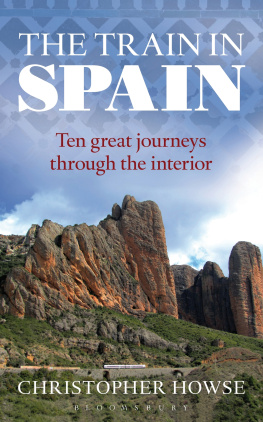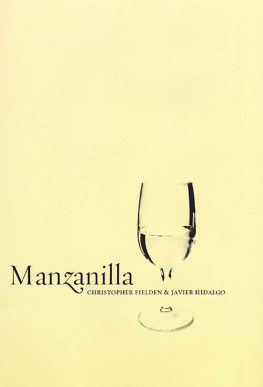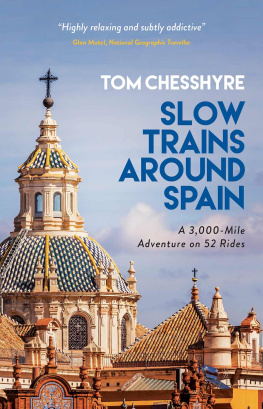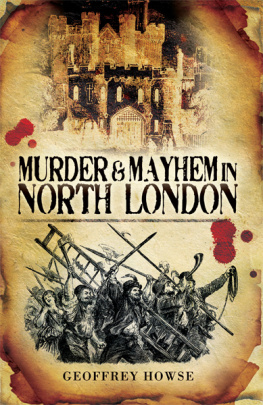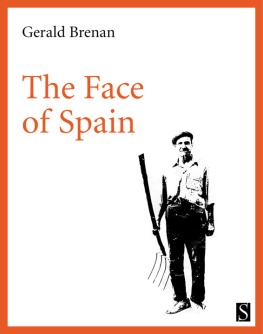THE TRAIN IN SPAIN
The Train in Spain
CHRISTOPHER HOWSE

First published in Great Britain 2013
Christopher Howse, 2013
The moral right of the author has been asserted
No part of this book may be used or reproduced in any manner whatsoever without written permission from the Publisher except in the case of brief quotations embodied in critical articles or reviews. Every reasonable effort has been made to trace copyright holders of material reproduced in this book, but if any have been inadvertently overlooked the Publishers would be glad to hear from them.
A Continuum book
Bloomsbury Publishing Plc
50 Bedford Square
London WC1B 3DP
www.bloomsbury.com
Bloomsbury is a registered trademark of Bloomsbury Publishing Plc
Bloomsbury Publishing, London, New Delhi, New York and Sydney
A CIP record for this book is available from the British Library.
ISBN 978-1-4411-2839-3
10 9 8 7 6 5 4 3 2 1
eBook by Fakenham Prepress Solutions, Fakenham, Norfolk NR21 8NN
Visit http://www.bloomsbury.com/ to find out more about our authors and their books.
You will find extracts, author interviews, author events and you can sign up for newsletters < http://www.bloomsbury.com/uk/newsletter > to be the first to hear about our latest releases and special offers
Contents
Sierra Mountains
Canfranc to Montserrat
Tierra Land
Barcelona to Betanzos
Bellotas Acorns
Zamora to Zafra
Buitres Vultures
Mrida to Cabeza del Buey
Sol Sun
Seville to Granada
San Juan de Aznalfarache
Cuevas Caves
Guadix to Chinchilla
Horchata Orgeat
Cuenca to Valencia
Ruinas Ruins
Tortosa to Medinaceli
Claro Of course
Bilbao to Len
Esparar Waiting
Burgos to Madrid
Plate section
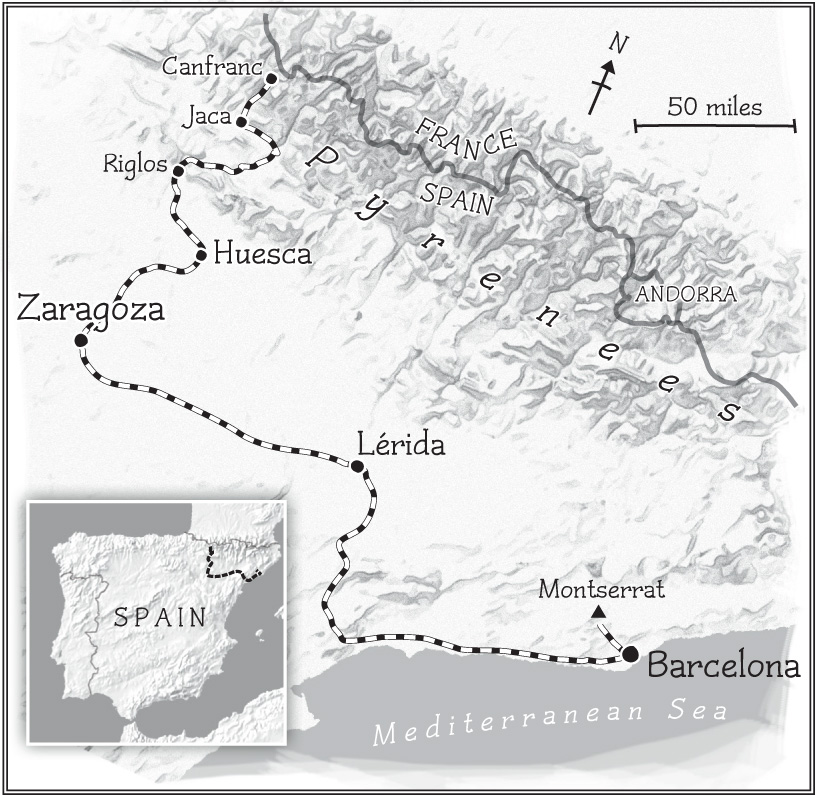
THIS IS a book about Spain, not about trains. Want a smoke? the guard had asked. Were stopping here for five minutes. That was at Sabinigo, in the foothills of the Pyrenees. The two or three other passengers in the single-carriage train had joined the driver, dressed in jeans and T-shirt, and the affable, portly guard in his grey uniform, for a cigarette and a chat. It was fresher out on the platform.
There was no smoking on board, but three hours of diesel fumes as the engine laboured uphill had made the back of the throat sore. The train had already climbed 2,000 feet from the heat and dust of Zaragoza in September, and had another 1,300 feet to conquer on the last leg of the journey up to Canfranc. Behind the train, strange cockscombs of rock ran across the sheep-bitten fields. Ahead, rose high, blue, geometrical peaks of broken cubes and pyramids.
LIKE A VAST Noahs Ark run aground, Canfranc station lay athwart a high pass of the Pyrenees. At 3,921 feet above sea level, this was no place for a station, especially such a station as this: 790 feet wide, wedged between peaks that send down avalanches from the French border.

To build it meant planting 8 million trees, in order to stabilise the winter snows, and carving a deep, stone-lined channel for the torrent of the river Aragn. (When Hilaire Belloc saw the Aragn here in 1909 it was a torrent at the door, in the words of his Tarantella, the song beginning, Do you remember an inn, Miranda?. He was unlikely to have admired its new ashlar straitjacket next to the station, as formal as a Versailles canal.)
At the opening of the line, in the heat of July 1928, the King of Spain (arriving in a train driven by the Duke of Zaragoza) joined the President of France to eat a lunch, sent up from Lhardys in Madrid, of scrambled eggs with truffles, sirloin with buttered peas, capons with ham and a selection of pastries. They then took the train through the 8,600-yard tunnel into France and had another lunch. The Pyrenees no longer exist, said King Alfonso XIII, daringly quoting Louis XIVs remark made under rather different circumstances.
But on Good Friday, 1970, only 42 years after the grand opening, the brakes of a goods train failed and it hurtled from the bridge at LEstanguet, on the French side. Trains never crossed the border again.
A deep stretch of the tunnel has since been colonised by a laboratory of astrophysicists. Today, on the Spanish side, the 56-seater train chugs up from Zaragoza less frequently and slightly more slowly than when the line opened. The traveller gets out at a platform opposite the boarded-up hulk of the grounded Ark and walks out into the little town of 624 people amid the mountain maples and ash trees, where the screech of a jay tears through the clear air.
IT WOULD, you would think, be downhill all the way from Canfranc. But there is a higher station in Spain, in the middle of the Iberian plateau, rather surprisingly on the local line through the suburbs of Madrid up into the Sierra de Guadarrama. There, the station at Cotos is at an altitude of 5,968 feet.
All Spain is raised up and walled in by mountains. The Tibet of Europe, Jos Ortega y Gasset called it in 1906, thinking no doubt of its separateness as much as its topography. The highest peak in the Pyrenees, Aneto, at 11,168 feet, is outdone by distant Mulhacn, beyond Granada in the Sierra Nevada, another 245 feet higher. Between the two, sierras rise in corrugations running east to west.
Every station in Spain has a plaque of cast iron fixed to the wall, giving its height above sea level. The solidity of these ovals of iron is almost as comforting as the rainbow that guaranteed to Noah that the waters should no more become a flood to destroy all flesh. The wording is as familiar as the label of a sauce bottle.
Direccin General del Instituto Geogrfico y Estadstico say the capital letters round the outside of the oval. At the centre is the height in Arabic numerals, in large type, breaking the exact line that indicates Altura sobre nivel medio del Mediterrneo en Alicante the height above the mean level of the Mediterranean at Alicante.
Why at Alicante? Because it was there, it seems, that the project to construct a national topographical map began. For a whole year, beginning in June 1871, the height of the sea at Alicante was taken at hourly intervals.
The spot from which the geodesists then set about triangulating their way towards Madrid was taken as the left-hand side of the first step of the slightly cracked red marble staircase in the lobby of the eighteenth-century Alicante Town Hall, on the newel post of which a brass plate records the honour. Compared with the sea, the step was found to be at a height of 3.4095 metres.
But its glory has departed, for this network of heights was made utterly obsolete by a survey covering the whole peninsula conducted between 2001 and 2007. Satellites have demolished the honour of the staircase of Alicante Town Hall.
AT CANFRANC there was no bus waiting. No one else had got off the train. No one was in the street. No cars passed. Birds chirped. It would be half an hours walk uphill to the solid stone shelter of the lonely hotel at Santa Cristina, on a still wild edge of the gorge of the river Aragn.

